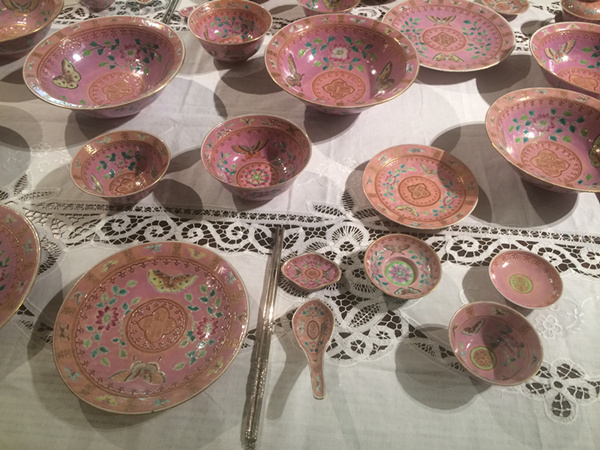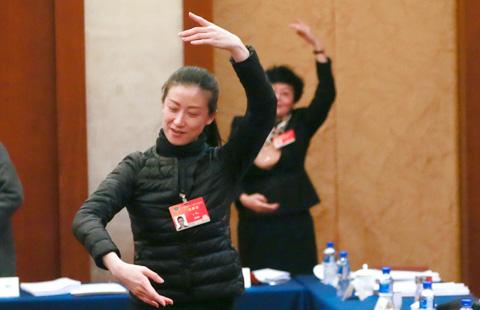Hybrid culture in a red dot
Updated: 2015-03-07 07:56
By Wang Chao(China Daily)
|
||||||||
 |
|
A set of the Peranakan-style kitchen wares. [Photo by Wang Chao/China Daily] |
The wedding decorations were all about bling - crowns for husband and wife were made by gold, gem and diamond, and even tablecloths were made from sparking bead embroidery. These tablecloths were made by thousands of tiny glass beads to form various auspicious patterns such as birds, peanuts, dates, and flowers. In the Peranakan culture, to have a happy marriage, these tablecloths were supposed to be made by the girl herself - probably since she could pick up a needle.
The guide in the museum told me that the Peranakan tradition is reviving. Ten years ago, nobody said he was a Peranakan, but nowadays, people all claim that have a certain Peranakan blood. Now being Peranakan is trendy. "After the museum opened, many young couples came to consult us about the Peranakan-style wedding, which was almost extinct decades ago," the guide said.
For those interest in local culture, the Waterloo Street is a must-go. Here you can see the amazing scene of an Indian temple Sri Krishnan Temple and Chinese Kwan Im Thong Hood Cho Temple siting side by side.
Strolling on the street, I passed stands and stands of fresh lotuses and chrysanthemums, which are sold to worship the deities. First I saw the colorful Indian temple, with the sculptures of two Indian gods guarding the gate. But strangely enough there are incense burners in front of the gate, which is a typical Buddhist practice.
The guide told me there were no incense burners outside the gate initially, but every morning when the Indians are worshipping, Chinese passers-by stop and burn incense outside to pay their tribute, and leave the ashes on the ground.
"People here are not exclusive in religion, whenever they see a temple or a church, they pay their tribute," the guide said.
The Kwan Im Thong Hood Cho Temple is the most powerful temple in Singapore, and it will make every wish come true, according to the introductions. Here I spent four Singapore dollars to buy a small bouquet, and made a wish inside the hall.
The next day I visited a traditional dragon kiln called Thow Kwang. The 20-meter-long kiln is built on a slop so when the fire is lit on the fire box, the hot air can rise all the way through the stretched kiln and heat the glazed pots placed in the kiln. The kiln is so large that each time 2,000 pieces of ceramics can be made.
The kiln was traditionally used to make Peranakan Chinese ceramics. But today the kiln has lost its original function and has become a gathering place for Singaporean artists to create something unpredictable.
Today electric kilns are widely adopted, but the dragon kiln is still the favorite of many artists. The flame generated by the wood and the ashes can give a magical tint to the glaze, and the unexpected effect is most exciting thing to see.
- China says DPRK leader meeting to happen when 'convenient'
- Cause of NW Chinese city odorous tap water identified
- Chinese woman stands for UN's aviation arm's elections
- Chinese FM gives press conference for NPC session
- China kicks off new inspections over top state firms
- 10,000-sq-m farm built on rooftop
- UK police detain trespasser who climbed to Parliament's roof
- Two suspects held over murder of Russian opposition leader
- A year on, what's the latest in the hunt for Flight 370?
- China asks Sri Lanka to protect interests of investors over suspended port project
- Chinese, Myanmar diplomats hold consultation on relations
- 5 dead in shooting at restaurant in Mali capital

 Chinese FM gives press conference for NPC session
Chinese FM gives press conference for NPC session
 One Minute: 'Bizarre' TV scenes and subsidies for hiring women
One Minute: 'Bizarre' TV scenes and subsidies for hiring women
 Daily snapshots of 'two sessions' - March 7
Daily snapshots of 'two sessions' - March 7
 MH370 families remember one year on
MH370 families remember one year on
 World celebrates International Women's Day
World celebrates International Women's Day
 Highlights on the Internet industry in Premier Li's work report
Highlights on the Internet industry in Premier Li's work report
 Daily snapshots of 'two sessions' - March 6
Daily snapshots of 'two sessions' - March 6
 Railway stations witness return peak across China
Railway stations witness return peak across China
Most Viewed
Editor's Picks

|

|

|

|

|

|
Today's Top News
China to speed up drafting anti-corruption law
A year on, what's the latest in the hunt for Flight 370?
China sincerely invites world leaders for WWII commemorations
Police kill black teen in US state of Wisconsin
Kerry briefs Europeans on Iran nuke talks
Don't magnify Sino-US disagreements, Wang says
Solar-powered plane prepares to fly around the world
Government plans to reform foreign investment law
US Weekly

|

|








